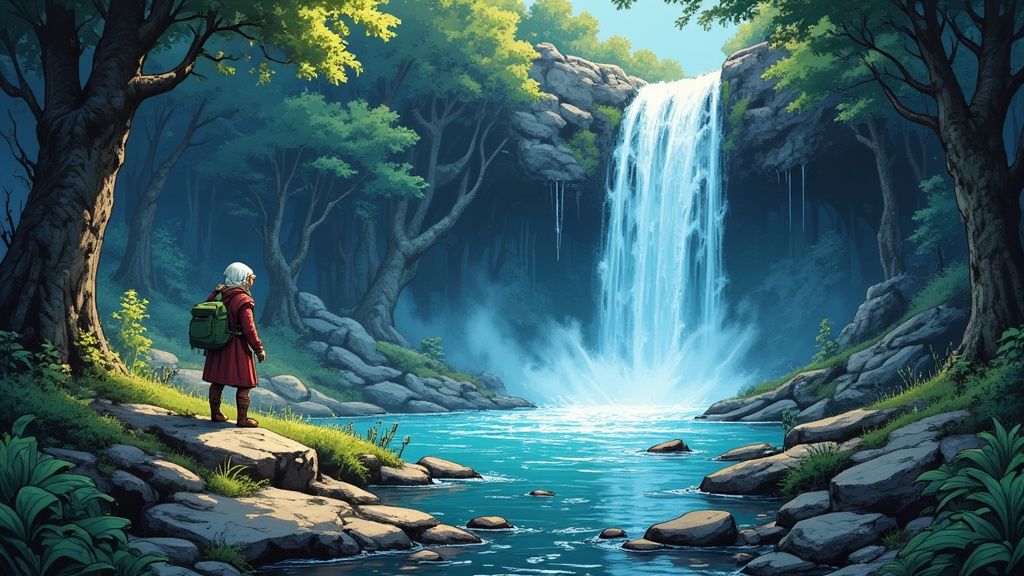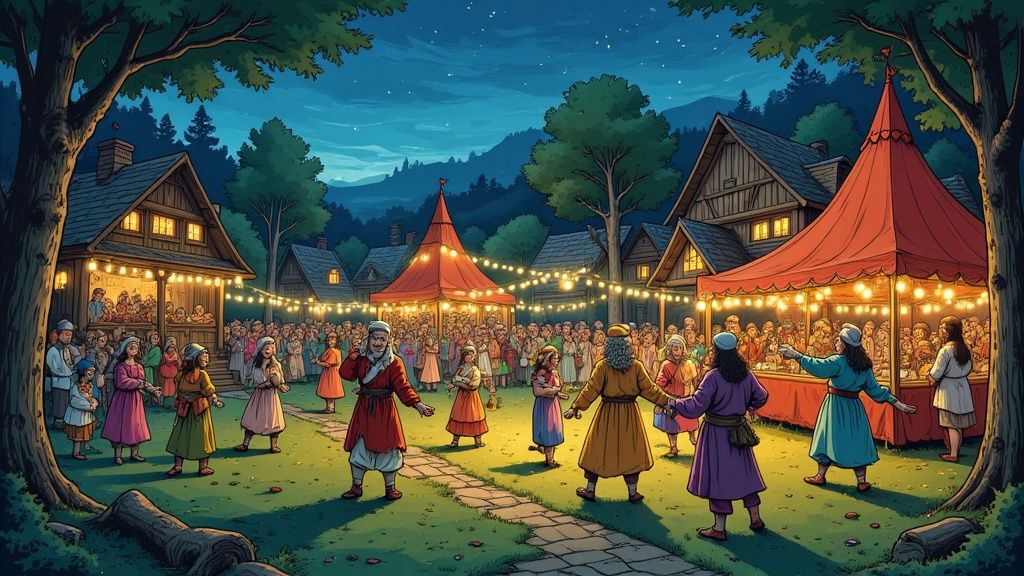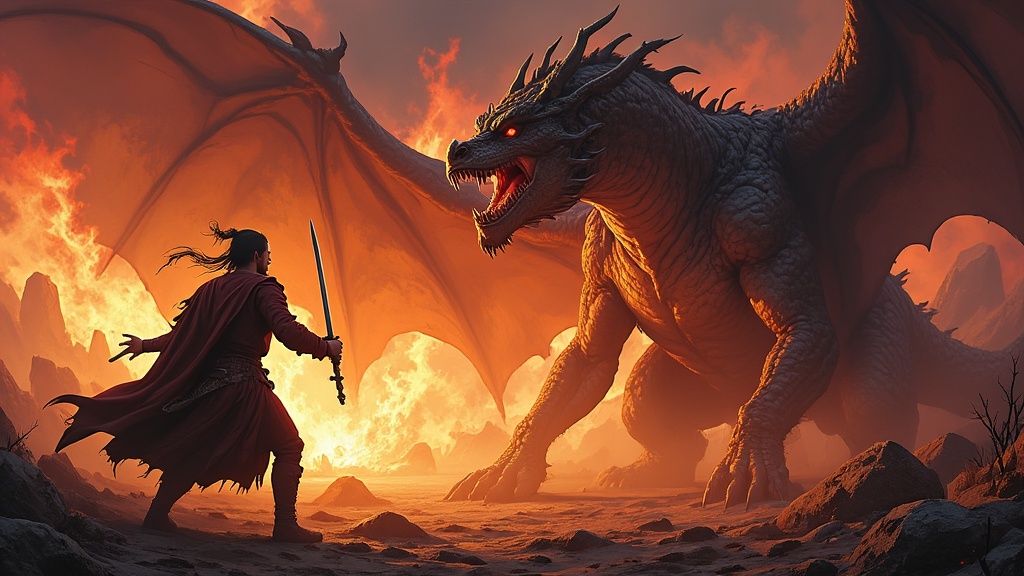Understanding the Evolution of Elvish Narratives

The journey of elvish tales from ancient folklore to modern fantasy is a captivating one. These stories have grown from simple tales of mischievous woodland spirits into rich narratives filled with complex characters and intricate worlds. Along the way, they've picked up new meanings and fresh interpretations, reflecting our changing views on magic, nature, and what it means to be different. Let's explore how these enchanting stories have evolved through time.
From Folklore to Fantasy: Tracing the Elvish Lineage
Back in the early days, elves weren't quite the graceful beings we picture today. In old stories, they popped up as small magical creatures who could be helpful one day and cause trouble the next. Take Scandinavian folklore, for instance – their "alfar" were fascinating creatures who could heal the sick or curse the healthy, keeping everyone guessing about their true nature. This early mix of good and bad traits set the stage for the more layered elf characters we love reading about now.
The Tolkien Influence: A Turning Point in Elvish Stories
Everything changed when J.R.R. Tolkien wrote The Lord of the Rings. His elves were something entirely new – wise immortals with an almost otherworldly beauty and a deep bond with nature. This fresh take on elves became the gold standard, inspiring countless writers who came after. Thanks to Tolkien, themes of immortality, nature connection, and ancient wisdom became must-haves in elf stories. But here's the fun part – modern authors aren't just copying his homework. They're taking these basic ingredients and cooking up their own unique recipes, adding special touches to make their elven worlds stand out.
Modern Adaptations: Keeping It Fresh While Honoring Tradition
Today's elf stories walk an interesting line between respecting Tolkien's foundation and breaking new ground. Some writers stick close to his playbook, while others venture into darker territory with more flawed characters. The Elfquest series offers a perfect example of this evolution. Starting as a black-and-white comic in 1978, it rode the waves of change in the comics world, switching between color and monochrome as needed. More importantly, it created rich, distinct elven cultures that added new depth to these magical beings. It's this dance between old and new that keeps elf stories exciting and relevant.
The Enduring Appeal: Why We Love Elf Adventure Stories
There's something special about elf adventure stories that keeps us coming back for more. Maybe it's how they whisk us away to magical places where ancient wisdom meets thrilling adventure. Whether we're following a quest for a lost treasure, getting caught up in elvish court drama, or watching an elf figure out who they really are, these tales give us a break from everyday life and a peek into something extraordinary. The fact that we keep telling and retelling elf stories shows just how much these magical beings and their worlds capture our imagination.
Mastering Core Elements of Elvish World-Building
Creating rich and engaging elf stories takes more than describing pointy ears and mystical forests. The most memorable tales pull readers into fully realized worlds with deep cultural roots, compelling social structures, and thoughtfully crafted magic systems. Let's explore the key elements that bring elvish worlds to vibrant life.
Building Believable Elvish Societies
The foundation of any captivating elvish world lies in its social fabric. Think about the core values and principles that shape how elves interact – do they follow strict hierarchies with noble houses and intricate protocols? Or do they embrace collective decision-making where wisdom and merit matter more than bloodlines? These social dynamics influence everything from daily interactions to major plot developments, helping readers understand the rules and stakes of your world.
The Magic of Elvish Magic Systems
Magic often defines elvish stories, but it needs clear rules to feel authentic. Rather than treating magic as a convenient plot device, develop a system with defined costs, limitations and sources of power. Ask yourself: Can any elf tap into magic, or is it a rare gift? Does their magic flow from nature itself, ancient artifacts, or something entirely different? By establishing consistent principles, magic becomes an integral part of the world rather than just a narrative shortcut.
Weaving Authentic Cultural Details
The small details breathe life into elvish cultures. From unique languages and greetings to art forms and celebrations, cultural touchstones make the world feel lived-in and real. Include glimpses of elvish music, crafts, and ceremonies – how do they mark important milestones? What traditions unite their communities? Even brief mentions of these elements build a rich sense of place and history.
Balancing Tradition with Innovation in Elvish Lore
While classic elvish stories offer valuable inspiration, don't be afraid to put your own spin on the genre. For instance, your elves might wrestle with limits on their lifespans rather than being purely immortal. Or they could have fascinating relationships with technology, selectively embracing certain advances while rejecting others. The Elfquest series, launched in 1978, demonstrated how to thoughtfully evolve elvish traditions by introducing distinctive cultures that felt fresh while honoring the core appeal of elves. This blend of familiar and novel elements keeps readers engaged while expanding what elvish stories can be. The key is finding your unique angle while maintaining the timeless magic that draws people to these tales.
Crafting Compelling Elf Adventure Stories

Now that we've explored the rich world of elvish lore, let's dive into the art of writing captivating elf adventure stories. Great elf tales do more than just entertain – they transport readers into magical realms where ancient traditions and personal journeys intertwine. Creating these stories requires a deep understanding of elvish culture and psychology to craft narratives that truly resonate with readers.
Character Development: Beyond the Archetype
Sure, we've all met the wise, otherworldly elf in countless stories. But the most gripping elf adventures dig deeper into what makes these immortal beings tick. Picture an elf grappling with centuries of memories and lost loved ones, or a young warrior challenging their society's ancient customs. The best characters reveal their hopes, fears and inner conflicts through their actions and choices. For instance, a gifted elven artisan might struggle between preserving traditional crafts and experimenting with new forms of creative expression.
Plot Structures: Weaving Intrigue and Action
The most memorable elf stories blend edge-of-your-seat action with emotional depth. While epic battles and magical quests keep readers turning pages, it's the personal stakes that make us truly care. Maybe your elf protagonist is searching for a legendary artifact to save their dying forest home. Or perhaps they're seeking redemption for past mistakes while racing to prevent an ancient evil from awakening. The key is connecting external conflicts to the character's inner journey.
World-Building Integration: Showing, Not Telling
Let your rich elvish world shine through natural details rather than exposition dumps. Instead of stating "elves have a deep bond with nature," show an elf character instinctively sensing a forest's distress or carefully gathering herbs while whispering ancient prayers of gratitude. Weave bits of elvish history and mythology into dialogue and pivotal story moments. This lets readers discover your world gradually through the characters' lived experiences.
The Modern Touch: Evolving Elf Adventure Stories
While honoring classic elements of elf tales, don't be afraid to explore fresh angles. How might an elven society react to neighboring kingdoms' technological advances? What happens when an elf falls in love with a human despite cultural taboos? Series like Elfquest have kept readers hooked for decades by putting creative spins on traditional themes. The best modern elf stories respect the past while blazing new narrative trails – keeping this beloved genre alive and growing for future generations of readers.
Cultural Impact and Modern Interpretations
The magic of elves continues to captivate audiences across all forms of media and storytelling. From blockbuster movies to indie video games, these ethereal beings have shown remarkable staying power in popular culture. Their enduring appeal stems from how creators keep finding fresh ways to reimagine ancient folklore for contemporary audiences.
Elves on the Screen: Film and Television Adaptations
The way we picture elves today owes a lot to how they've been portrayed on screen. Peter Jackson's The Lord of the Rings films gave us those graceful, immortal beings that now pop into most people's minds when they think "elf." But shows like Netflix's The Witcher have started pushing boundaries, showing us elves who are complex and flawed rather than purely noble. This mix of old and new keeps elf stories exciting and gives creators room to explore deeper themes.
Elves in Pixels: The Influence of Gaming
Video games have opened up whole new worlds of elvish adventure. Whether you're exploring vast forests in The Elder Scrolls or waging epic battles in Warcraft, games let you step into elvish shoes in ways books and movies never could. Players don't just watch elves – they become them, making choices that shape their stories. The massive popularity of elf characters in World of Warcraft shows just how much people love experiencing life through elvish eyes.
The Digital Realm: Fanfiction and Online Communities
The internet has turned elf stories into a group project, with fans building on existing worlds through their own creative works. Online communities share stories, artwork, and ideas, keeping classic elements alive while adding their own modern twists. This collaborative storytelling shows how elf tales can grow and change while staying true to what makes them special.
Modernizing Myths: Reinterpreting Traditional Elements
Today's writers and artists are finding clever ways to make ancient elvish themes relevant to modern life. Some stories use elves to explore environmental issues or social justice, while others imagine how elvish society might deal with modern technology. These fresh takes keep elf adventures meaningful for current audiences while honoring their mythological roots. Take Elfquest, which brought new life to elf stories through comics. And interest in elves remains strong – a 2022 survey in Iceland found that belief in these magical beings still persists today. With endless possibilities for new stories and interpretations, it looks like elves will keep enchanting us for years to come.
Navigating Common Pitfalls in Elvish Fantasy

Writing compelling elf stories takes more than sprinkling in some pointed ears and magical forests. While these classic elements help set the stage, creating memorable elvish tales requires carefully balancing beloved traditions with fresh ideas. Let's explore the key challenges authors face and how to overcome them to craft stories that truly captivate readers.
The Trap of Tolkien's Shadow
We all know and love J.R.R. Tolkien's elves, but simply copying his vision can lead to stories that feel stale and predictable. Instead of just recycling the usual traits – immortality, wisdom, and nature-bonding – try putting an interesting spin on them. What if your elves see their endless life as a curse rather than a blessing? Or what if their connection to nature becomes complicated when their forest home faces destruction? By examining these classic elements from new angles, you can create elves that feel both familiar and fresh.
Avoiding the "Perfect Elf" Stereotype
Let's face it – too many stories paint elves as flawless beings who never make mistakes. While it's tempting to write them this way, perfect characters often end up boring and hard to relate to. Give your elves real struggles and inner conflicts. Maybe they're wrestling with guilt over past actions or questioning long-held beliefs. These flaws and internal battles make them feel like real people rather than idealized statues.
Building Beyond the Forest
Sure, elves and forests go together like peanut butter and jelly. But limiting them to woodland settings cuts off tons of story possibilities. Picture elves adapting to bustling modern cities, surviving harsh deserts, or even building civilizations under the sea. How would their nature magic work in these new environments? What challenges would they face? Exploring these fish-out-of-water scenarios can lead to fascinating conflicts and character growth.
Respecting Cultural Nuances
Creating believable elvish societies means digging deeper than just making up pretty names and languages. Think about their social structures, religious beliefs, art, food, and daily life. While you can draw inspiration from real-world cultures, be thoughtful about it – avoid turning your elves into shallow stereotypes. The comic series Elfquest shows how to do this right, building distinct elvish cultures that feel authentic and three-dimensional.
Finding Your Unique Voice
The fantasy shelves are packed with elf stories, so standing out means bringing something new to the table. You don't have to throw out every classic element, but look for fresh angles to explore. What if elven society was torn apart by bitter political rivalries? What if using magic came with devastating personal costs? By asking these kinds of "what if" questions, you can create stories that feel both comfortably familiar and excitingly different.
Building Lasting Impact Through Elvish Tales

Ever wonder why elf stories keep enchanting readers decade after decade? The secret lies not just in pointed ears and magical powers, but in how these tales touch something deep within us. Let's explore what makes elvish adventures stick with us long after we close the book.
The Power of Archetypes and the Elvish Resonance
Think about Legolas from The Lord of the Rings – his character hits all the right notes that make elves fascinating. The graceful warrior, the wise immortal, the nature-connected being – these qualities speak to ideals we admire and aspire to. But modern stories aren't afraid to show elves' flaws too. For instance, when writers reveal the pride or prejudice beneath that perfect exterior, it makes these characters even more relatable. This mix of the ideal and the imperfect keeps readers coming back for more.
World-Building as a Foundation for Impact
The best elf stories build worlds so rich in detail that they feel like real places you could visit. Just look at how J.R.R. Tolkien crafted Middle-earth – complete with its own languages, maps, and thousands of years of history. When writers put this much care into their world-building, readers can't help but get lost in the story. The magical realm becomes as much a character as any elf or human in the tale.
Crafting Enduring Narratives Through Emotional Depth
Sure, magic and adventure are fun, but it's the emotional core that makes these stories truly memorable. Take the Elfquest series – since 1978, it's kept readers hooked not just with cool elf designs, but with complex relationships and deep cultural bonds. When elvish tales tackle universal themes like love, loss, and belonging, they create connections that last well beyond the final page.
Balancing Tradition and Innovation
The trick for modern elf storytellers is finding fresh angles while respecting what makes these tales special. Shows like The Witcher prove you can put new spins on elves without losing their essence. Some writers emphasize the darker aspects of immortality, while others explore how elves might handle modern problems. This keeps the genre exciting while holding onto the magic that drew us to elf stories in the first place.
Embrace the Naughty Side of Christmas with That Naughty Elf
Want to add some grown-up giggles to your holiday season? That Naughty Elf puts a cheeky twist on the classic elf tradition. Share your own mischievous elf photos, vote on the naughtiest setups, and bring some playful fun to your Christmas celebrations. It's like Elf on the Shelf grew up and discovered their wild side! Head over to their website for some holiday humor that'll make Santa blush.